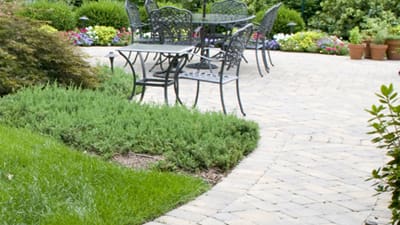 Outdoor walkways and pathways can add beauty and interest to your landscape. They can provide a lovely pathway to a pool, an outdoor garden or a cozy bench in the yard.
Outdoor walkways and pathways can add beauty and interest to your landscape. They can provide a lovely pathway to a pool, an outdoor garden or a cozy bench in the yard.
Outdoor walkways offer many uses for your northern NJ home, so it’s important to make sure they’re well-designed.
Design possibilities for outdoor walkways and pathways are endless. They can be built in almost any size and shape you need. Walkways can be built with subtle materials that blend the landscape or colorful materials that add visual interest. Your walkway design and your choice of outdoor walkway materials can have a major impact on your landscape.
Before you decide on design and materials, think about what the walkway will be used for. Does the walkway lead somewhere or does it serve a purely aesthetic purpose in your landscape? Outdoor walkways can be installed for many reasons:
- Direct foot traffic to a specific location.
- Define a border around a specific area.
- Draw people into a gorgeous garden.
- Draw people to a fountain or focal point.
- Add texture and color to the landscape.
- Add contrast to foliage with hardscaping.
When you have defined the purpose of your walkway, you can make better decisions on design and outdoor walkway materials. Don’t underestimate the impact of a beautiful, well-designed outdoor walkway. Many homeowners don’t put enough thought into landscape walkways and pathways and miss a perfect opportunity to enhance their home.
Outdoor Walkway Materials
There are a variety of materials that can be used for outdoor walkways in Bergen County. Before choosing a material, ask yourself some important questions that may impact your selection.
- Is it a high traffic walkway?
- Is it the main traffic path to your front door?
- Is it in the front yard or back yard?
- Will you be rolling trash cans or garden equipment over it?
- Will it be in a high maintenance area of the yard?
How your walkway will be used is important to selecting the right outdoor walkway materials. Take a look at your choice of materials, along with the benefits or disadvantages they provide.
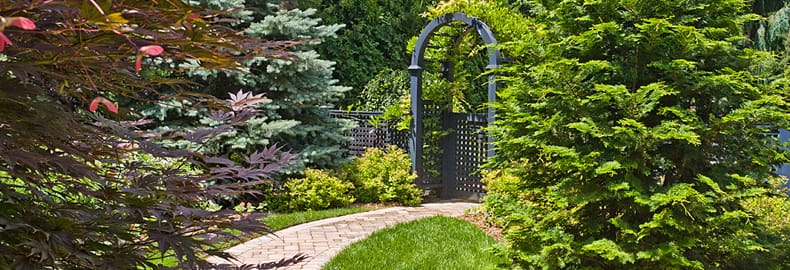
Concrete
Concrete walkways can provide a lot of curb appeal. Today, they aren’t the plain, gray, smooth surfaces that you may think about when you visualize concrete. Concrete has become a popular choice for outdoor walkways and pathways due to many new decorative options. Gray is still the most popular concrete color, but there are many more color and pattern options that will create amazing results. Concrete comes in over 30 pre-mixed colors and 15 stained colors.
Concrete options include:
- Poured Concrete – If you want a smooth even surface, poured concrete is great. There are no seams and no patterns, unless you want them. Poured concrete can take on any shape and it can be scored or divided into sections when wet.
- Concrete Pavers – Concrete pavers come in various sizes, shapes and textures. Interlocking pavers come with edge spacers and joints that fit together like puzzle pieces. They don’t need grout or mortar.
- Stamped Concrete – Stamped concrete mimics other outdoor walkway materials like stone or slate. By using different patterns and shapes, you can create a beautiful walkway that looks like more expensive natural stone.
Concrete offers a durable, resilient and cost-effective choice for outdoor walkway materials. It’s suitable for all outdoor uses, including driveways. It has a slip-resistant surface and easily withstands freezing ground temperatures without cracking or chipping. It’s easy to clean and maintain with soap and water. Concrete pavers are easy to replace if damaged, and they come with a lifetime warranty. For added protection from stains, use a sealer.
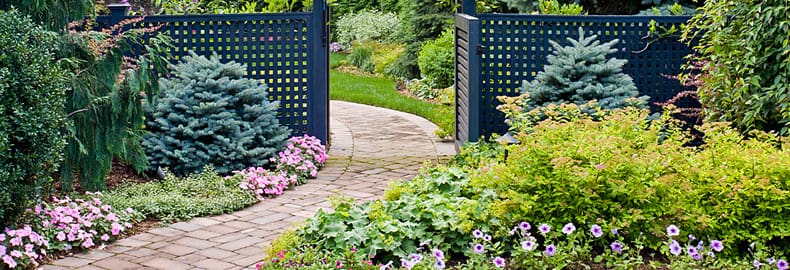
Natural Stone
Natural stone is the most popular of all the outdoor walkway materials, however it’s also the most expensive. It’s hard to beat the beauty of natural stone. It looks great in formal, casual and rustic landscapes. Stone pavers are available in granite, marble, limestone, travertine and slate. They come in rectangular and square shapes in various sizes from 6” x 12” up to 24” squares. They’re available in a variety of colors and rough finishes (tumbled or honed) or polished finishes.
- Granite – Made from igneous rock found deep within the earth, granite is the hardest and least porous of all the natural stones. It’s strong, durable and will hold up well in cold northern NJ temperatures.
- Marble – Marble is a metamorphic rock with colorful veins that run through the stone. It’s available in many color variations and rough or polished finishes. It does require a sealer for outdoor use.
- Limestone – Limestone contains traces of fossils from marine life and shellfish that give it a rich, light-colored appearance. It’s available in tumbled and polished finishes. Limestone is porous and requires a sealer for outdoor use.
- Travertine – Similar to limestone, travertine contains lime deposits that give it variegated colrs. It’s available in rich colors and tumbled and polished finishes. Travertine is porous and requires a sealer for outdoor use.
- Slate – Slate is a strong, durable stone that holds up well outdoors. Its strong color variations create a lot of texture and visual interest in a landscape setting. It’s a great choice when you want contrast in your outdoor walkway materials.
Natural stone provides a beautiful, natural appearance. It has a naturally rough surface that creates texture. It provides a durable and resilient surface for outdoor walkway materials, but it is porous and needs to be sealed once or twice a year for protection from spills, stains and adverse weather conditions. The main disadvantage of using natural stone is higher costs.
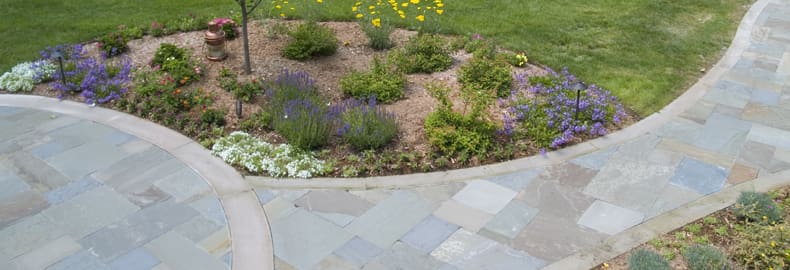
Aggregate Stone and Rock
If you’re looking for outdoor walkway materials that have a natural, rustic appeal, aggregate stone and rock are good choices. They don’t provide the formal, sophisticated look that natural stones have. Aggregate stone and rock materials are great for natural, free-form gardens and landscapes.
- Aggregate Stone – Crushed stone, pea stone and other aggregate stones create a very casual landscape walkway. As loose stones, they are very inexpensive and easy to install. To create a more tailored look, you can add edging or foliage between the walkway and the lawn.
- Rock – Flagstone and river rock work well for casual and rustic landscapes. They wear well without a sealer, but you can seal them for added stain protection if you wish. If you use a sealer, use a matte finish to retain a natural look.
Aggregate stone and rock are very inexpensive to install. A walkway could be installed in one day. Crushed stone and pea stone need to be packed down with a plastic or cloth barrier underneath. Since these outdoor walkway materials are loose stones, they can stick to your shoes or get kicked off the walkway into the yard.
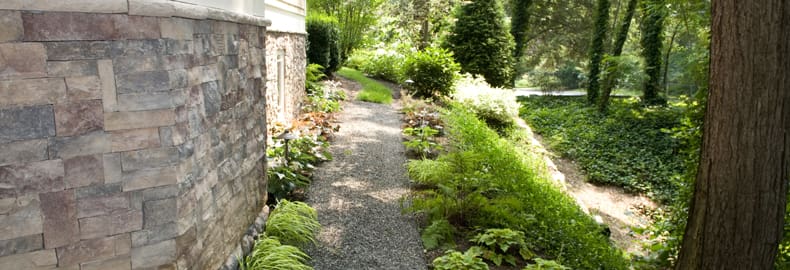
Brick
Brick outdoor walkways create a classic, timeless look. They have a traditional appeal, especially when bricks are laid in herringbone patterns rather than straight patterns. Brick outdoor walkway materials come in full size bricks that require mortar, as well as interlocking brick pavers that are much thinner. Colors include typical red brick and muted shades of green, rust, brown, tan and beige. Brick pavers come in various sizes and finishes that look like new or old bricks.
Brick is a durable, strong material for outdoor walkways. It’s easily cleaned with a garden hose and strong water pressure. It dries quickly in the sun, but can form a slick mossy film if left in moist shady areas. Although brick is somewhat porous, a sealer isn’t usually necessary. Talk to your Bergen County landscape contractor about using a sealer for your brick outdoor walkways.
